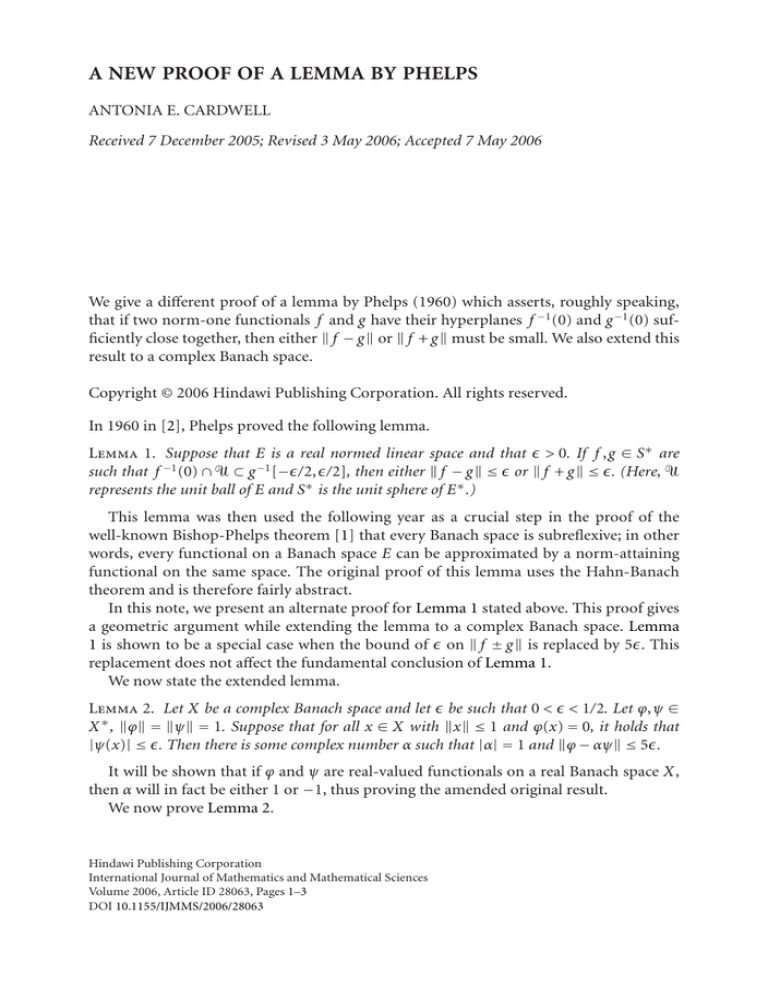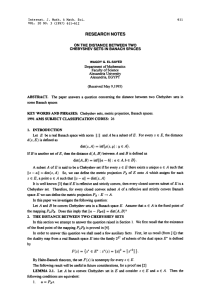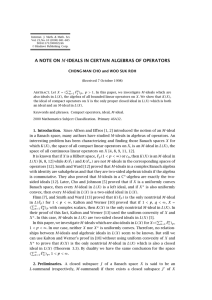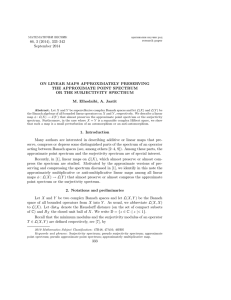
A NEW PROOF OF A LEMMA BY PHELPS
ANTONIA E. CARDWELL
Received 7 December 2005; Revised 3 May 2006; Accepted 7 May 2006
We give a different proof of a lemma by Phelps (1960) which asserts, roughly speaking,
that if two norm-one functionals f and g have their hyperplanes f −1 (0) and g −1 (0) sufficiently close together, then either f − g or f + g must be small. We also extend this
result to a complex Banach space.
Copyright © 2006 Hindawi Publishing Corporation. All rights reserved.
In 1960 in [2], Phelps proved the following lemma.
Lemma 1. Suppose that E is a real normed linear space and that > 0. If f ,g ∈ S∗ are
such that f −1 (0) ∩ ᐁ ⊂ g −1 [−/2, /2], then either f − g ≤ or f + g ≤ . (Here, ᐁ
represents the unit ball of E and S∗ is the unit sphere of E∗ .)
This lemma was then used the following year as a crucial step in the proof of the
well-known Bishop-Phelps theorem [1] that every Banach space is subreflexive; in other
words, every functional on a Banach space E can be approximated by a norm-attaining
functional on the same space. The original proof of this lemma uses the Hahn-Banach
theorem and is therefore fairly abstract.
In this note, we present an alternate proof for Lemma 1 stated above. This proof gives
a geometric argument while extending the lemma to a complex Banach space. Lemma
1 is shown to be a special case when the bound of on f ± g is replaced by 5. This
replacement does not affect the fundamental conclusion of Lemma 1.
We now state the extended lemma.
Lemma 2. Let X be a complex Banach space and let be such that 0 < < 1/2. Let ϕ,ψ ∈
X ∗ , ϕ = ψ = 1. Suppose that for all x ∈ X with x ≤ 1 and ϕ(x) = 0, it holds that
|ψ(x)| ≤ . Then there is some complex number α such that |α| = 1 and ϕ − αψ ≤ 5.
It will be shown that if ϕ and ψ are real-valued functionals on a real Banach space X,
then α will in fact be either 1 or −1, thus proving the amended original result.
We now prove Lemma 2.
Hindawi Publishing Corporation
International Journal of Mathematics and Mathematical Sciences
Volume 2006, Article ID 28063, Pages 1–3
DOI 10.1155/IJMMS/2006/28063
2
A new proof of a lemma by Phelps
Proof. Let e ∈ X be such that e = 1 and |ϕ(e)| ≥ 1 − /4. We will first show that |ψ(e)|
≥ 1 − (5/2). To see this, let f ∈ X such that f = 1 and |ψ( f )| ≥ 1 − /4. Let k =
1 − /4 and let t = ϕ( f )/ϕ(e). Then 0 ≤ |t | ≤ 1/(1 − /4) = 1/k ≤ 8/7 and if we take
w = (k/(k + 1))( f − te), then w ≤ (k/(k + 1))( f + |t |e) ≤ (k/(k + 1))(1 + 1/k) = 1.
Moreover,
ϕ(w) =
ϕ( f )
k
ϕ( f ) −
ϕ(e) = 0
k+1
ϕ(e)
(1)
so we have
≥ ψ(w) =
k ψ( f ) − tψ(e)
k+1
k ψ( f ) − |t |ψ(e)
k+1
k ψ( f ) − |t |ψ(e) .
≥
k+1
≥
(2)
Thus
1
ψ(e) ≥ |t |ψ(e) ≥ ψ( f ) − k + 1 ≥ 1 − − k + 1 = k − k + 1 .
k
k
4
k
k
(3)
This gives
2 2
2
ψ(e) ≥ k 2 − (k + 1) = 1 − − 2 − = 1 − + − 2 + ≥ 1 − 5 4
4
2
16
4
2
(4)
as required. Notice that, if ϕ and ψ are real valued, the above still holds.
Now, there exist β,γ ∈ C such that |β| = |γ| = 1, βϕ(e) ∈ [1 − /4,1] ⊂ R, and
γψ(e) ∈ [1 − 5/2,1] ⊂ R; and so |βϕ(e) − γψ(e)| ≤ 5/2.
Let x ∈ X be such that x ≤ 1 and write x = λe + y, where λ = ϕ(x)/ϕ(e) and y =
x − λe. Then |λ| ≤ |ϕ(x)|/ |ϕ(e)| ≤ 1/(1 − /4) ≤ 8/7, y ≤ x + |λ|e ≤ 15/7, and
ϕ(y) = ϕ(x) − (ϕ(x)/ϕ(e))ϕ(e) = 0. So, by hypothesis, |ψ((7/15)y)| ≤ , that is, |ψ(y)| ≤
(15/7). Then, if we take α = γ/β, we have |α| = 1 and
ϕ(x) − αψ(x) = 1 βϕ(x) − γψ(x) = βλϕ(e) + βϕ(y) − γλψ(e) − γψ(y)
|β|
8 5
15
≤ |λ|βϕ(e) − γψ(e) + |γ|ψ(y) ≤ · + 1 · = 5.
7 2
(5)
7
But x was an arbitrary element of the unit ball of X, so we have ϕ − αψ ≤ 5.
Notice that if X is a real Banach space, the above argument still holds. Also, if ϕ and
ψ are real valued, we can choose e ∈ X such that ϕ(e) ≥ 1 − /4, giving β = 1, and then
from the claim, either γ = 1 or γ = −1. So either α = 1 or α = −1, yielding Phelps’ result,
up to a constant.
Antonia E. Cardwell 3
References
[1] E. Bishop and R. R. Phelps, A proof that every Banach space is subreflexive, Bulletin of the American Mathematical Society 67 (1961), 97–98.
[2] R. R. Phelps, A representation theorem for bounded convex sets, Proceedings of the American
Mathematical Society 11 (1960), no. 6, 976–983.
Antonia E. Cardwell: Department of Mathematics, Millersville University of Pennsylvania,
Millersville, PA 17551-0302, USA
E-mail address: antonia.cardwell@millersville.edu









